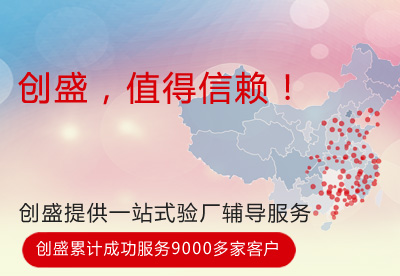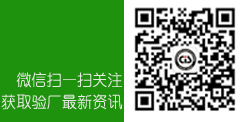Target验厂Chuangsheng Csr
122016-3
TARGET对C-TPAT反恐验厂要求
信息来源:验厂之家 浏览次数:2730次
The Customs-Trade Partnership Against Terrorism (C-TPAT) Medium Audit General Guidelines are for the purpose of defining general rules as they apply to the C-TPAT Medium Audit form. These guidelines are an overview of the considerations to be taken with the questions. This standard should be used in conjunction with the C-TPAT Medium Audit Form.
The C-TPAT Medium Audits are completed as part of the Factory Evaluation process. The C-TPAT Medium Audit should be completed by the same person completing the Factory Evaluation.
The information you provide when completing a C-TPAT Medium Audit is important and is used in many ways:
Allows International Supply Chain Security to identify security concerns and work with the vendor to correct them
Assists International Supply Chain Security in basic prioritization of C-TPAT security audits
Provides information on factories where C-TPAT audits have not been conducted
Provides documentation for media, non-governmental organizations (NGO’s), and shareholders that TSS/AMC has looked at security concerns in a particular factory
For Target orders, the medium audit is also used to verify information provided to International Supply Chain Security at the time of C-TPAT registration
Frequency requirements of conducting a C-TPAT Medium Audit are as follows:
Complete one C-TPAT Medium Audit for each Factory Evaluation per factory.
Medium Audits should be completed for both TSS/AMC and non-TSS/AMC factories/orders
Please obtain the C-TPAT Medium Audit questionnaire and best method from email or EOL (Experts Online). The C-TPAT Medium Audit questions will be on a separate, temporary Excel form until FAS-T rolls out to the field. All required fields will need to be completed in full to obtain a ‘completed’ status. Required fields are indicated by an asterisk ( * ) preceding the question on this Standard. Failure to complete a required field will result with an ‘incomplete’ status. The completed audit forms should be sent via email to global.security@target.com. Please also retain a copy of the completed questionnaire in the local TSS/AMC office.
GENERAL INFORMATION
*Date of Visit
Complete this field using the date of your visit to the factory. Use the format MM/DD/YY. (example: 05/12/04 represents May 12th, 2004)
Date Form is Received by ISCS
The International Supply Chain Security (ISCS) Team in Minneapolis will fill in this field. NO ACTION REQUIRED BY THE FIELD
*Field Assessment Factory ID
Complete this field with the factory F#, if known. (example: F00001234).
The factory ID number is found in BPM (Business Partner Management)
If you do not know the factory ID, please leave this field blank.
*Inspector Name/Title:
Complete this field with the evaluator’s name and title.
*Inspector Office/Country:
Complete this field with the evaluator’s office city and country location.
*Reason for Visit:
Please check the appropriate reason for your visit for the following options:
o Factory Evaluation
o Global Compliance Audit
o OTHER (If this option is checked, write the reason for your visit in the space provided)
FACTORY INFORMATION
*Factory Name and Address:
Complete the Factory’s name and address
City/Town/Village
Country
Province/State
*Contact Person:
Complete the name of an English speaking contact person.
VENDOR INFORMATION
*Place the name of the vendor(s) on these lines.
C-TPAT SECURITY QUESTIONS
(You may ask factory management to assist you in answering the following questions)
1. Is there a high security seal affixed to each container/trailer that meets ISO/PAS (17712) standards?
Physically check the seals that are used in sealing the containers or ask management what type of seal is used if no container seal is available.
High security seals include bar lock seals, bolt seals, and cable seals.
If a bar, bolt or cable seal is not used, answer NO to question one.
2. Does the factory have procedures in place on how seals are controlled and affixed to containers/trailers?
Physically check to see if seals are kept in a locked and secured place prior to applying to a container and logged on the Container Load Plan (Container Load Plan may not be available in factory for initial Factory Evaluation or Compliance Audit) or another form of a container seal log. If no seals are available ask management where seals are kept.
Another form of a seal log should include, but not limited to: date/time container is sealed, seal number, container number, and employee identification and number that completed the container sealing process.
If containers are present and sealed, physically check if the container is sealed by viewing the seal and container locking mechanism for tampering. Verify the seal number against the documentation. Tug on the seal to make sure it is affixed to the container. Twist and turn the seal to make sure it does not unscrew.
If seals are not kept in a locked and secured place prior to applying to a container and not logged on the Container Load Plan or another form of container seal log, answer NO to question two.
Reference Container Load Plan on page 7.
3. Is the container/trailer sealed at the factory immediately after loading?
Ask management or observe if containers are sealed immediately after loading.
If containers are not sealed immediately after loading, answer NO to question three.
4. Does the factory have procedures in place for designated employees to distribute container/trailer seals?
We define employees to distribute container/trailer seals to include security personnel and/or a manager/supervisor.
Ask management or physically view procedures to know who distributes the seals, if a security personnel and/or manager/supervisor is not mentioned, answer NO to question four.
5. Does the factory have a container/trailer seal log?
Ask a manager/supervisor to physically see the Container Load Plan or another form of a container seal log.
Another form of a seal log should include, but not limited to: date/time container is sealed, seal number, container number, and employee identification and number that completed the container sealing process.
If you are not presented one of the two container seal logs, answer NO to question five.
Reference Container Load Plan on page 7.
6. Are containers/trailers stored in a secure area to prevent unauthorized access?
Physically check to see if containers/trailers (trucks for less than container load product) are stored or parked within the fence/physical barrier surrounding the facility, or door to door/end to end, or backed against a structure high enough to keep doors from opening to prevent tampering/pilferage. If containers/trailers/trucks are not present ask management how containers/trailers/trucks are stored or parked.
If no container/trailer is available please continue to ask management how containers/trailers are stored.
If the factory does not have one of these four methods for storing containers/trailers/trucks, answer NO to question six.
7. Does the factory have procedures in place to verify physical integrity of the container/trailer by using the seven point inspection prior to loading?
Ask a manager/supervisor to physically see the seven point inspection check list for verifying the physical integrity of a container. If the factory does not have the seven point inspection check list, ask to see their documented procedure for verifying the physical integrity of the container.
We define checking the physical integrity of the container as, but not limited to checking the front wall, left side, right side, floor, ceiling/roof, inside/outside doors, and outside/undercarriage of the container.
If the factory does not have the seven point inspection check list or a procedure to verify the physical integrity of a container, answer NO to question seven.
Reference Seven Point Inspection Check List on pages 8-9.
8. Does a security fence or physical barrier surround the facility?
Physically check to see if a fence surrounds the factory. The height of the fence should be around 7 to 8 feet high (2.13 to 2.43 meters). If the fence is lower answer “yes” and include the height information in the comment section.
If there is no fence, look to see if a physical barrier surrounds the factory. Physical barriers can include brick/cement walls or a solid barrier.
If the factory does not have one of these two security barriers surrounding the facility, answer NO to question eight.
9. Are all gates through which vehicles and personnel enter/exit manned and/or monitored by security personnel?
When you arrive at the factory physically check to see if you need to pass through a gate to get into the premise. The gate needs to be monitored by a person or a camera.
If the factory does not have a person or camera to monitor the gate(s), answer NO to question nine.
10. Does the factory have employee/visitor parking areas segregated from all cargo handling and storage areas?
Physically check to see if employee/visitor parking areas are segregated from all cargo handling and storage areas. We define parking being segregated by means of not being able to park in the same area as the cargo handling and storage areas. If cargo handling and storage areas are segregated by a barrier, it is classified as segregated from all other areas.
If the factory does not have employee/visitor parking segregated from cargo handling and storage areas, answer NO to question ten.
11. Are buildings constructed of materials that resist unlawful entry?
We define building materials that resist unlawful entry to be steel, cement and bricks.
If the factory does not have one of the three materials listed, answer NO to question eleven.
12. Does the factory have external and internal windows, gates, and fences secured with locking devices?
Physically check to see if each of the following has a locking device on them; windows, gates, and fences. You do not have to verify all windows, gates, and fences have a locking device. Verify that at least two of them do.
Locking devices may be unlocked during business hours, but they must have a locking device in place.
If the factory does not have one the above criteria, answer NO to question twelve.
13. Does lighting illuminate the building entrances and exit areas?
Physically check to see if lights are present in the building entrances and exit areas.
If the factory does not have lighting the building entrances and exit areas, answer NO to question thirteen.
14. Does lighting illuminate the cargo handling and storage areas?
Physically check to see if lights are present in the cargo handling and storage areas.
If the factory does not have lighting the cargo handling and storage areas, answer NO to question fourteen.
15. Does outside lighting illuminate the fence line?
Physically check to see if lights are present on the fence line.
If the factory does not have lighting on the fence line, answer NO to question fifteen.
16. Does lighting illuminate the parking area?
Physically check to see if lights are present in the parking area.
If the factory does not have lighting the parking area, answer NO to question sixteen.
17. Does the factory have a system in place to identify employees?
Ask to see badges or ask a manager/supervisor if the factory is capable of identifying their employees. We define identifying employees as having a work badge, a work uniform, or a name tag stating employee on it.
If the factory does not have a system in place to identify employees, answer NO to question seventeen.
18. Do visitors present photo identification for documentation purposes prior to entry?
We define photo identification as a government or work issued license/badge. An example would be a driver’s license, passport or work badge.
When you arrive at the factory, are you asked to present identification to be granted access?
If you are not asked for identification, answer NO to question eighteen.
19. Are all visitors escorted and visibly display temporary identification?
We define temporary identification as a badge stating visitor on it, a sticker with visitor written on it, or a device that can be attached to a person identifying them as a visitor.
When you tour the factory, are you escorted?
If you are not required to wear a visitor badge and you are not escorted, answer NO to question nineteen.
20. Is application information, such as employment history and references verified prior to employment?
Ask a manager/supervisor if it is legal to verify employment history and/or references prior to employment. If it is legal ask the manager/supervisor if employment history and/or references are verified prior to employment.
If it is legal and if employment history and/or references are not verified prior to employment, answer NO to question twenty.
21. Does the factory have procedures in place to remove identification, facility and system access for terminated employees?
Ask to view the procedure to remove identification, facility and system access for terminated employees.
We define a procedure for removing identification, facility and system access for terminated employees as, but limited to, date/time of removal, terminated employees name, a record of the identification system device being returned, and the employee name and identification that completed the termination.
If the factory does not have a procedure, answer NO to question twenty one.
22. Are drivers delivering or receiving cargo positively identified before cargo is received or released?
We define photo identification as a government or work issued license/badge. An example would be a driver’s license, passport or work badge.
Ask a manager/supervisor when drivers arrive at the factory, are drivers asked to present identification to be granted access? Ask a manager/supervisor to physically see the truck/container check in/check out log or the truck/driver log.
If drivers are not asked for identification and the factory does not have one of the logs mentioned, answer NO to question twenty two.
23. Does the facility have Target Corporation’s Integrity Hotline information displayed throughout?
Ask a manager/supervisor to physically show you where Target Corporation’s Integrity Hotline information is displayed.
If the factory does not have Target Corporation’s Integrity Hotline information displayed, answer NO to question twenty three.
Copy of the CONTAINER LOAD PLAN
(May not be available if this is initial Factory Evaluation or Compliance Audit)
Factory/Vendor:
Container No.
Seal Number(s)
Consignee:
Container Delivery Date:
CY or CFS?
Carrier:
Port of Loading:
Port of Discharge:
Initial Inspection of container
Remarks/Comments:
External condition of the container/externo
OK/Bien
Roof condition of the container/techo:
OK/Bien
Wall condition of the container/paderes:
OK/Bien
Floor condition of the container/piso:
OK/Bien
Door condition of the container/puerta:
OK/Bien
Other/otros:
OK/Bien
Total
Total
Total
ROW:
DPCI
PO#
Style #
CTNS
VCP
Pcs/Items
Kilos/Item
Cbms/Item
Grand Total
Shipment Release/Inspection Certification (AMC/TSS Vendor Only)
Date of Inspection and Inspector:
Employee Who Sealed Container
Employee ID
Date Container Sealed
Time Container Sealed
Copy of the Seven Point Inspection Check List
***Must complete at least two checks in each section***
Front Wall
Checks Completed
Ensure interior corner blocks are visible and not false, and front wall is made of corrugated material.
FORMCHECKBOX
Use a 40’ chain with a marker in the middle to take an interior measurement from the front wall to the rear door of both 40-foot and 20-foot containers. The 40-foot container should measure 39’5” or 12.01 meters. The 20-foot container should measure 19’4”or 5.89 meters.
FORMCHECKBOX
Ensure ventilation holes are visible, not covered or absent.
FORMCHECKBOX
Use a tool to tap the front wall, there should be a hollow sound.
FORMCHECKBOX
Left Side
Checks Completed
Look for unusual repairs to structural beams
FORMCHECKBOX
Look for repairs on the walls that are visible on the inside and outside of the container.
FORMCHECKBOX
Use tool to tap on the sides, there should be a hollow sound.
FORMCHECKBOX
Right Side
Checks Completed
Look for unusual repairs to structural beams
FORMCHECKBOX
Look for repairs on the walls that are visible on the inside and outside of the container.
FORMCHECKBOX
Use tool to tap on the sides, there should be a hollow sound.
FORMCHECKBOX
Floor
Checks Completed
Measure the height of the container from floor to ceiling. A 40-foot and 20-foot container should measure7’10” or 2.38 meters.
FORMCHECKBOX
Ensure that the floor of the container is flat. There should not be different floor heights in the container.
FORMCHECKBOX
Look for unusual repairs in the floor.
FORMCHECKBOX
Ceiling/Roof
Checks Completed
The construction of false ceilings/roofs can be either internal or external.
FORMCHECKBOX
Observe the distance between the top of the corner block and the top of the roof, e.g., normally the roof is slightly below or flush with the top of the corner blocks.
FORMCHECKBOX
Ensure that the ventilation holes are visible, not covered or absent.
FORMCHECKBOX
Look for repairs on the ceiling/roof that are visible on the inside and outside of the container.
FORMCHECKBOX
Use a tool to tap on the ceiling/roof, there should be a hollow sound.
FORMCHECKBOX
Inside/Outside Doors
Checks Completed
Ensure that the container door has secure and reliable locking mechanisms.
FORMCHECKBOX
Observe the rivet type and color, they should not be different colors or have colored putty surrounding the rivets.
FORMCHECKBOX
Ensure that there are not solid plates, where there are usually cavities.
FORMCHECKBOX
Outside/Undercarriage
Checks Completed
The outside/undercarriage of a container should be inspected before it enters the facility.
FORMCHECKBOX
Inspect the underneath of the containers visually or with a mirror to make sure that all support beams are visible and no foreign objects are mounted to the container.
FORMCHECKBOX
Look for repairs on the outside that are visible on the inside of the container.
FORMCHECKBOX
Use a tool to tap on the outside/undercarriage, there should be a hollow sound.
FORMCHECKBOX
本文发自CSR创盛验厂之家,转载请写明出处,文章编辑:CSR创盛验厂之家,更多请查看创盛TARGET验厂咨询专题http://www.csr007.com/target/
Copyright © 2025 www.chuangshengcsr.com 东莞市创盛企业形象策划有限公司
地址:广东省东莞市南城区鸿禧中心A区608室 电话: 0769-22324329/22362295 粤ICP备11014164号
地址:广东省东莞市南城区鸿禧中心A区608室 电话: 0769-22324329/22362295 粤ICP备11014164号








